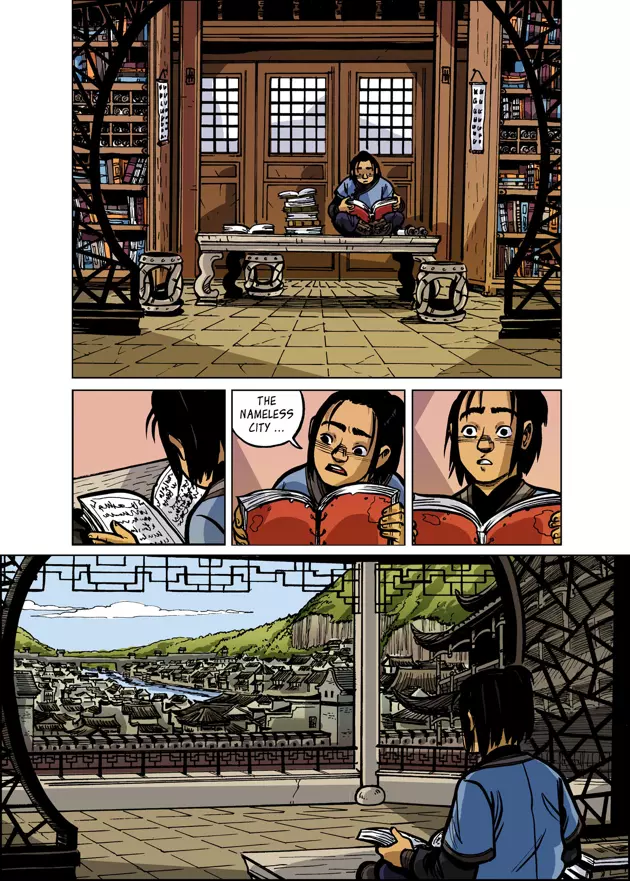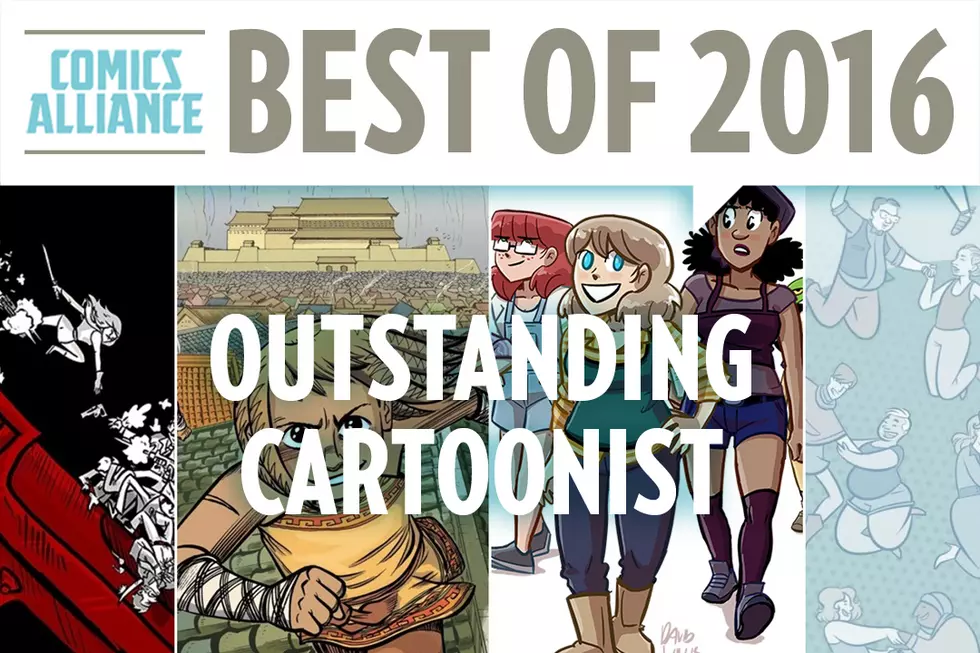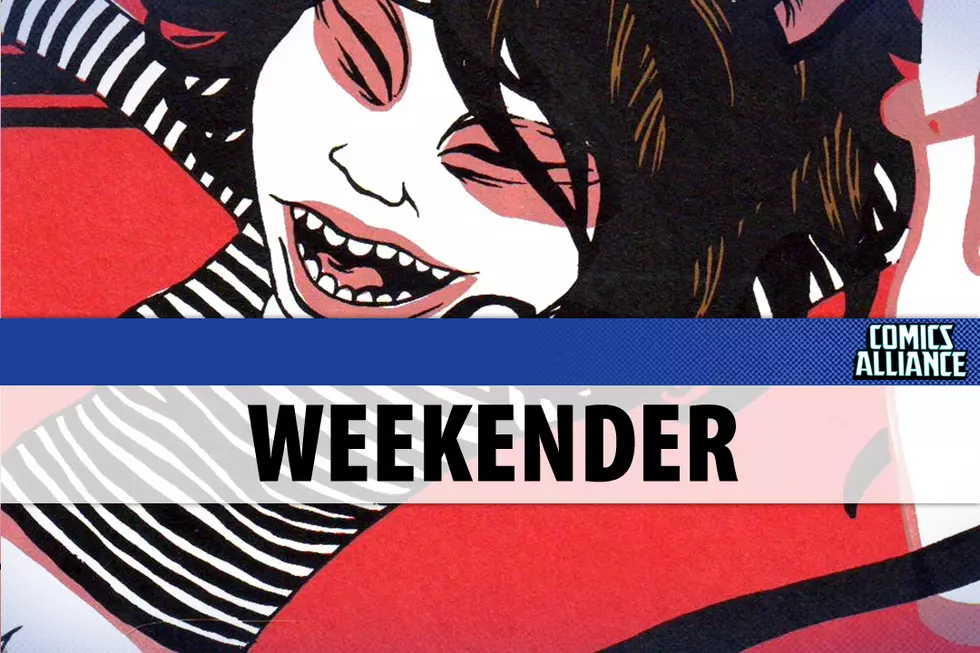![Faith Erin Hicks Talks Eisner Win, Adapting Y.A. Prose, And Drawing ‘The Nameless City’ [Interview]](http://townsquare.media/site/622/files/2014/07/CA_NamelessHeader.jpg?w=980&q=75)
Faith Erin Hicks Talks Eisner Win, Adapting Y.A. Prose, And Drawing ‘The Nameless City’ [Interview]
Faith Erin Hicks is one of North American comics' most versatile talents, a writer/artist who's gained critical acclaim and commercial success, and raised her profile with each successive project she's released over her 15+ year career.
This year's San Diego Comic-Con was particularly eventful for Hicks, as she announced her new graphic novel series from First Second books and won an Eisner Award for Dark Horse's collection of her The Adventures Of Superhero Girl webcomic. We caught up with her in San Diego the morning after the Eisner awards to talk about current projects.

ComicsAlliance: Well to start things off, the big news is that you just won an Eisner for The Adventures Of Superhero Girl…
Faith Erin Hicks: I did win an Eisner! Oh my gosh! I cried and I'd actually prepared a speech ahead of time and I heard – Kelly Sue DeConnick and Matt Fraction were announcing the category and I heard my name, and my first thought was, "I have to go up there as quickly as possible because otherwise, they're going to say that there's been a mistake and it's not for me." So I tore up towards the stage and ran onstage and realized I'd forgotten my speech and I couldn't sop crying and… It was a moment. A really wonderful moment. I don't know, to win an Eisner, it's tangible proof that my work is good, and to be honored in that way is very special. The respect of peers means so much to me.
CA: And you're now working on a new project for First Second…
FEH: Yes! I'm working on a new middle-grade fantasy trilogy called The Nameless City and I'm really excited about it. It's a little bit based on China during the thirteenth century, and it's about two kids who live in a city – the city has been conquered for many, many years, it's a constant source of conflict because it's very important to the flow of trade throughout this fantasy world that I've created. And these two kids meet: one's a member of the ruling elite, and the other is a street kid who's been orphaned by the conflict, and they end up butting heads and then eventually becoming begrudging friends and become entangled in conspiracies and murders and assassinations. Action and adventure happens, and it's pretty much everything I want to draw at this point in my life.
CA: You say it's loosely based on feudal China?
FEH: Well, the setting is based on that particular time period, but there's no historical link between the story that I'm telling and and events that happened in that period. I just used it as the inspiration for my story's setting.
CA: If you weren't worried about historical accuracy, did you still spend time researching? And did you limit your research to that period, or did you pull in some elements of other things?
FEH: I did a little bit of research on later periods, but most of it was specifically influenced by the Mongol dynasty that oversaw China during the thirteenth century.
CA: So how are you pitching this to people and what terms do you use to describe it? "Young Adult Fantasy" and "YA Fiction" both seem to conjure up specific images, and almost typecast works.
FEH: "For people who like Avatar: The Last Airbender"! A few years ago [First Second] kinda sat me down and asked what sort of comics I'd like to make in the future, and my response was that I really want to make a comic like Bone. Jeff Smith is one of my artistic heroes, and I feel like Bone inspired me to try to take up a larger story, and a story that wasn't in a contemporary setting – up until this point, most of my stories have been contemporary YA stories, kids in high school.

CA: And while I love Nothing Could Possibly Go Wrong and your other comics, it's great to see you stretching out like this and taking on a project that's such a departure. I got a glimpse of a couple pages-in-process from the new book, and it looks like you're pushing your art in a slightly different direction – tailoring your technique to fit the story you're telling, without losing your individual style.
FEH: Thank you! I try to do that. Of course, as you say, it looks like my work, but… I try to approach each project differently, and for this one, I did a lot of research, I have a lot of pictures and images of historical Chinese houses and that sort of thing. I really wanted to approach in with the perspective of "this is a real world". It's a fantasy that I created, but it's based on the real world, and I really wanted that solidity to be there in my drawing.
Also, up until this book, I'd always worked completely traditionally: pencilling on bristol board, and then inking with a brush. With this book, I purchased a Cintiq, mostly because I saw my peers – people like Cameron Stewart – working digitally, doing good work, and also being fast. And I'm always looking for ways to produce comics faster because they take so long to do! So I've been pencilling this book digitally, on my Cintiq, and then printing the pages out and inking them traditionally.
CA: And I guess having those physical pieces has the added benefit of circumventing one of the only problems I've heard people mention about working digitally – the lack of original art to sell.
FEH: Well, I'm one of the artists who…I don't really get lots of revenue from original art. Most of the time when I sell my pages, interest tends to be from people who want to buy pages from The Last Of Us, or an Adventure Time short I did, that kind of thing. At this point, I do get some requests for my original work, for Friends With Boys and Nothing Could Possibly Go Wrong, but at this point, it's not a large part of my revenue stream, so it's nothing I'm that concerned about.

CA: So with Nothing Can Possibly Go Wrong… It's one of my favorite "teen movie"-style comics of recent years, but you didn't write it, you adapted it from a pre-existing novel, right? How did that come to pass?
FEH: I was given this novel by Prudence Shen; it was originally titled Voted Most Likely, and I was given free rein to adapt it to comics. The novel was very long – if I had adapted it as it was written, literally, the graphic novel would have been close to 700 pages long. It had a lot more basketball in it, it had a lot more internal conflict, but basically I took what I felt were the main events of the novel and the main character moments, and lifted them out and adapted that template to comics.
CA: Was there any back-and-forth between you and Prudence during the adaptation, or were you left mostly on your own?
FEH: There was some minor back-and-forth – Prudence was very generous, she gave me free reign to adapt as I saw fit, and I really appreciated that. Every now and then I would rewrite or add little bits of dialogue in, to make a situation more clear, but for the most part I was lifting the dialogue out of the original prose novel.

CA: So do you enjoy hopping between different types of books… Going from working on a real-life-based comic to something that's more of a fantasy story?
FEH: Yeah, it's fun to be honest! My editor actually makes fun of me for saying this, but after I finished NCPGW, I felt like if I did another contemporary teen story, and I had to draw more school hallways, I would go insane. I was just like "I can't do it anymore – I can't draw any more lockers! No more school lockers!"
That was one of the reasons I really, really wanted to do Nameless City, because the setting is so different. It's completely different from what I drew in NCPGW. However, there is a part of me that does enjoy drawing contemporary teenagers in a modern setting. I'm actually working with the YA author Rainbow Rowell, best known for writing Eleanor & Park and Fangirl, and the story that we're creating together will be a contemporary YA romance with some fantasy elements to it. So it'll be fun switching back and forth! It keeps me interested, y'know?

The Nameless City graphic novel series launches in 2016 from First Second Books.
More From ComicsAlliance




![What Happened to All the Movie Panels in Hall H? [SDCC 2016]](http://townsquare.media/site/442/files/2015/07/comicconposter.jpg?w=980&q=75)

![Heroic Friend Fiction: Kamala’s Stories Come to Life in ‘All-New All-Different Avengers’ Annual #1 [Preview]](http://townsquare.media/site/622/files/2016/07/annual_featured.jpg?w=980&q=75)


